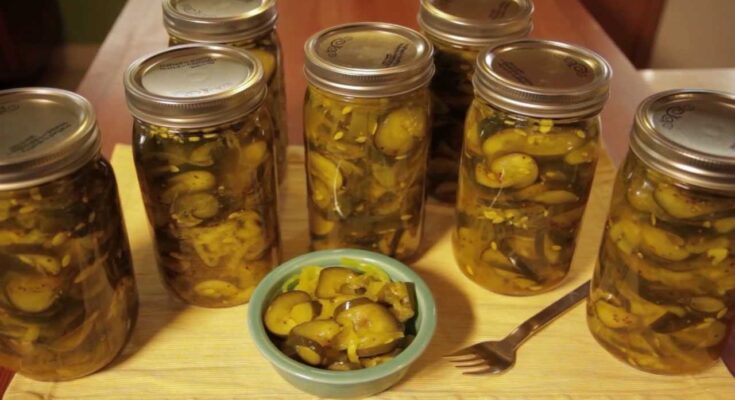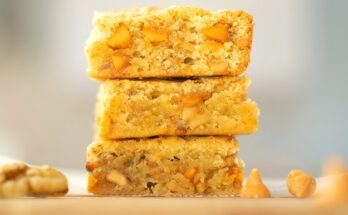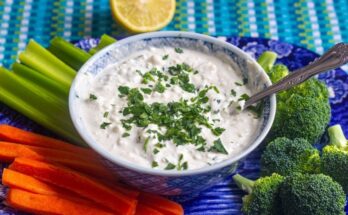Pickle Relish Recipe: Pickle relish is a tangy, sweet, and sometimes spicy condiment made from finely chopped vegetables—most commonly cucumbers, bell peppers, and onions. It’s a staple addition to hot dogs, burgers, and sandwiches, adding an irresistible crunch and punch of flavor. Unlike regular pickles, relish is minced finely and cooked in a vinegar-based brine, giving it a smoother texture and more balanced taste. It’s the secret ingredient that transforms a simple meal into something zesty and refreshing.
Why Make Your Own Pickle Relish at Home?
Making pickle relish at home gives you full control over flavor, texture, and ingredients. You can adjust the sweetness, tanginess, and spiciness to your liking. Store-bought versions often contain preservatives and added sugars, but homemade relish is fresh, vibrant, and naturally flavorful. Plus, it’s budget-friendly and an excellent way to use up excess cucumbers from your garden. Imagine the satisfaction of topping your burger with relish you made from scratch—pure homemade magic in every bite!
Ingredients You’ll Need
Main Ingredients for Pickle Relish
Here’s what you’ll need to make a classic batch of homemade pickle relish:
| Ingredient | Quantity | Purpose |
|---|---|---|
| Cucumbers (firm and fresh) | 6 cups, finely chopped | Main base of the relish |
| Onion | 1 large, chopped | Adds depth and sweetness |
| Green bell pepper | 1, chopped | Adds freshness and color |
| Red bell pepper | 1, chopped | Adds sweetness and visual appeal |
| White vinegar | 2 cups | Provides acidity and preservation |
| Sugar | 1 cup | Balances the tangy vinegar |
| Mustard seeds | 2 tsp | For flavor and crunch |
| Celery seeds | 1 tsp | Adds aromatic undertones |
| Salt (non-iodized) | 2 tbsp | Draws out moisture and enhances flavor |
These simple ingredients come together to create that perfect balance between sweet, sour, and savory—everything a good relish should be.
Optional Add-Ins for Extra Flavor
If you want to elevate your relish to the next level, try adding:
- Chili flakes or jalapeños for a spicy kick.
- Turmeric for color and earthy aroma.
- Garlic for extra depth.
- Fresh dill for a more traditional dill pickle relish taste.
Feel free to experiment; relish is forgiving and flexible. You can tailor it to match your personal flavor preferences.
Equipment and Tools You’ll Need
Before you begin, gather the following tools:
- Sharp knife or food processor
- Large mixing bowl
- Colander for draining
- Medium-sized saucepan
- Wooden spoon for stirring
- Sterilized jars with lids for storage
Having everything prepped makes the process smooth and efficient.
Step-by-Step Guide to Making Pickle Relish
Step 1 – Preparing the Vegetables
Start by finely chopping cucumbers, onions, and green or red bell peppers. You can use a food processor for even texture but avoid turning them into a puree — small, crisp bits are ideal. Aim for about 4 cups of chopped vegetables in total.
Step 2 – Salting and Draining the Mixture
Place the chopped vegetables in a large bowl and sprinkle with ¼ cup of salt. Mix well, then cover with cold water. Let it sit for 2 hours — this draws out excess moisture and helps preserve the crunch. After soaking, drain the mixture thoroughly and press out any remaining water using a clean kitchen towel.
Step 3 – Cooking the Relish Base
In a large pot, combine 2 cups of vinegar, 1 cup of sugar, and spices such as mustard seeds, celery seeds, and turmeric. Bring this mixture to a gentle boil, stirring until the sugar dissolves completely. The aroma will be sweet, tangy, and slightly spicy — the essence of good relish!
Step 4 – Combining and Simmering
Add the drained vegetable mix to the simmering liquid. Stir well and let it cook over medium heat for about 10 minutes, stirring occasionally, until everything is tender and the flavors meld together.
Step 5 – Canning or Storing Your Pickle Relish
Spoon the hot relish into sterilized jars, leaving a little headspace at the top. Seal tightly and process in a boiling water bath for 10 minutes if you want long-term storage. Otherwise, let cool and store in the fridge for up to 2 months. Perfect for hot dogs, burgers, or sandwiches — tangy, crisp, and full of homemade charm!
Variations of Pickle Relish
Sweet Pickle Relish
Sweet pickle relish is a fan favorite, especially for those who love that sugary, tangy balance. To make it, just increase the sugar to 1½ cups and use apple cider vinegar instead of white vinegar for a milder, fruity flavor. This version pairs wonderfully with hot dogs, tuna salad, or potato salad.
If you like your relish bright and vibrant, add a pinch of turmeric—it gives a golden hue and a subtle earthiness. The key to great sweet relish is balance: not too sugary, but sweet enough to complement savory dishes perfectly.
The best part? Sweet relish can double as a secret ingredient in dressings and sauces. Try mixing it into mayo for a quick tartar sauce or adding it to deviled eggs for a pop of flavor!
Spicy Pickle Relish
If you enjoy a bit of heat, spicy pickle relish will be your new favorite condiment. Add chopped jalapeños or red chili flakes to the vegetable mix before cooking. For a smoky note, toss in a dash of smoked paprika or cayenne pepper.
This fiery relish adds excitement to grilled meats, tacos, and sandwiches. You can even spoon it over scrambled eggs for a flavorful breakfast upgrade.
When making spicy relish, remember that heat intensifies as it sits. So if you’re unsure, start with less spice—you can always add more later, but you can’t take it out!
Dill Pickle Relish
Craving that classic dill flavor found in store-bought pickles? Go for a dill relish version. Add fresh or dried dill weed to your simmering mixture—about 2 tablespoons should do the trick. Reduce the sugar slightly to let the dill and vinegar shine through.
Dill relish is perfect for topping burgers, mixing into coleslaw, or serving alongside grilled fish. It’s bright, herbal, and has that nostalgic “old-fashioned pickle” taste that pairs with almost anything.
Try combining both sweet and dill versions for a “sweet-dill hybrid”—the ultimate blend of tart and sweet that’s pure perfection on hot dogs.
Expert Tips for Perfect Pickle Relish Every Time
Texture and Consistency Tips
The magic of relish lies in its texture—crunchy yet smooth enough to spoon easily. To achieve this balance:
- Don’t over-process your vegetables. Hand-chopped or lightly pulsed veggies retain crunch.
- Drain thoroughly after salting. Excess moisture leads to watery relish.
- Simmer gently—too much heat can make vegetables mushy.
If you accidentally overcook it, stir in a few fresh cucumber bits at the end for added crunch. Little fixes like that can save your batch!
Balancing Sweetness and Tanginess
Every palate is different. If your relish tastes too sour, add a pinch more sugar. Too sweet? Add a splash of vinegar or a squeeze of lemon juice. For a well-rounded flavor, mustard seeds and celery seeds are must-haves—they provide that signature relish kick.
Also, consider your vinegar type: white vinegar gives sharp acidity, while apple cider vinegar brings mellow fruitiness. Mix the two if you want a balanced, gourmet flavor.
Serving Suggestions
How to Use Pickle Relish in Everyday Dishes
Pickle relish is incredibly versatile—it can brighten up countless meals. Here are some delicious ways to use it:
- Hot dogs & hamburgers: A classic combo for a reason—adds tang and crunch.
- Tuna or egg salad: A spoonful makes the flavor pop.
- Potato salad: Adds a perfect sweet-sour contrast.
- Sandwich spread: Mix with mayo for a zesty dressing.
- Deviled eggs: A dash of relish transforms ordinary eggs into a crowd-pleaser.
You can even mix it into your homemade barbecue or tartar sauce. Once you start using it, you’ll find yourself adding it to almost everything!
Creative Recipe Ideas with Pickle Relish
Think beyond the basics—relish can enhance all kinds of dishes:
- Relish pasta salad: Add a spoonful to give your pasta salad a sweet-tangy twist.
- Glazed chicken or pork: Brush a relish-based glaze for a flavor explosion.
- Relish grilled cheese: Spread a thin layer inside your sandwich before grilling—it’s life-changing!
- Relish vinaigrette: Mix with olive oil and mustard for a bold salad dressing.
Homemade relish isn’t just a condiment—it’s a flavor booster. Once you start experimenting, you’ll realize it’s your secret weapon in the kitchen.
Storage and Shelf Life
How Long Does Pickle Relish Last?
One of the best things about homemade pickle relish is its impressive shelf life—especially if you store it correctly. When properly canned in sterilized jars, your relish can last up to 12 months in a cool, dark pantry. The vinegar and sugar work as natural preservatives, keeping the relish fresh and flavorful for a long time.
Once you open a jar, store it in the refrigerator, where it will stay fresh for about 4 to 6 weeks. Always use a clean spoon when scooping out relish; introducing contaminants can shorten its lifespan.
If you’ve made a refrigerator-only batch (not canned), keep it sealed tightly and chilled. The flavor may even deepen over time as the ingredients continue to blend. You’ll notice the relish getting more balanced and aromatic after a few days.
Homemade relish is one of those kitchen staples that gets better with age—like fine wine, but zesty!
Signs Your Relish Has Gone Bad
Even though relish has great shelf stability, it’s important to know when it’s time to toss it. Watch out for these warning signs:
- Off smell: If it smells sour, rotten, or musty, it’s no longer safe to eat.
- Mold or discoloration: White, fuzzy growth or dark spots are clear signs of spoilage.
- Gas bubbles: If you see bubbling or pressure inside the jar (and it wasn’t carbonated), discard it immediately.
- Unsealed lids: For canned relish, if the lid pops up or is loose, air may have entered, leading to contamination.
When in doubt, always err on the side of caution. Food safety comes first—no condiment is worth a risk!
Health Benefits of Homemade Pickle Relish
Nutritional Value and Low-Calorie Advantage
Homemade pickle relish isn’t just tasty—it’s surprisingly nutritious. Each spoonful packs in vitamins from the vegetables and is naturally low in calories and fat. A tablespoon of relish usually has only about 15–20 calories, making it a guilt-free way to add flavor to your meals.
Since you control the ingredients, you can reduce sugar or use natural sweeteners like honey or stevia. Plus, unlike commercial relishes loaded with preservatives, homemade versions are cleaner and more wholesome.
Cucumbers, the main ingredient, are hydrating and rich in antioxidants, while vinegar helps regulate blood sugar and supports metabolism. So yes—adding relish to your burger can actually be a smart move for your health!
Gut Health and Fermentation Benefits
Although most relish recipes are vinegar-based (not fermented), you can create a fermented version for extra gut benefits. In fermentation, natural bacteria convert sugars into lactic acid, preserving the vegetables while boosting probiotics.
Fermented relish supports digestion, enhances nutrient absorption, and promotes a healthy gut microbiome. To make it, simply skip the vinegar and let the salted vegetables sit at room temperature for a few days until naturally tangy.
Even without fermentation, vinegar-based relish helps with digestion thanks to its acidity—it stimulates your digestive juices and adds a refreshing kick to heavy meals. A spoonful alongside meats or fried foods can make them easier to digest and more enjoyable to eat.
Common Mistakes to Avoid
Overcooking or Undercooking the Relish
Getting the texture just right can be tricky. Overcooking makes your relish mushy, while undercooking leaves the vegetables too crunchy. The secret? Simmer it gently for 10 to 15 minutes, stirring occasionally. That’s long enough to let flavors meld without turning your veggies into soup.
Always taste as you go. The relish should have a slight crunch but feel cohesive. Remember, it will thicken slightly as it cools, so stop cooking before it gets too dry.
Incorrect Canning Techniques
Canning might sound intimidating, but it’s simple once you know the rules. The biggest mistake people make is not sterilizing jars properly. Always boil them for at least 10 minutes, and use new lids to ensure a proper seal.
Another common error is not processing the jars long enough in a water bath. This can lead to spoilage or bacterial growth. For relish, a 10-minute boiling water bath is usually perfect.
Finally, don’t overfill your jars. Leave about ½ inch of headspace at the top to allow for expansion during sealing. Once done, check that each lid is tightly sealed before storing.
Proper canning ensures your hard work doesn’t go to waste—and your relish stays safe, flavorful, and shelf-stable.
FAQs about Pickle Relish Recipe
1. Can I use cucumbers with seeds for relish?
Yes, but it’s best to scoop out the seeds if they’re large or watery. Seedless cucumbers or pickling cucumbers produce a firmer, crisper texture.
2. How can I make sugar-free pickle relish?
You can substitute sugar with natural sweeteners like honey, stevia, or monk fruit. Adjust to taste since sweetness levels vary.
3. What’s the difference between relish and chutney?
Relish is typically tangier and made with vinegar, while chutney is thicker, often fruit-based, and includes spices like ginger or cloves.
4. Can I freeze pickle relish?
Yes! Freeze it in small airtight containers for up to 3 months. Thaw in the fridge before using—it might lose a bit of crunch but will still taste delicious.
5. How do I fix relish that’s too watery?
Simmer it a little longer to reduce excess liquid, or add a tablespoon of cornstarch mixed with water to thicken slightly while cooking.
Conclusion
Making your own pickle relish is one of those rewarding kitchen projects that combines creativity, tradition, and flavor. With just a few simple ingredients and a bit of patience, you can craft a condiment that’s tangy, sweet, crunchy, and completely customizable to your taste.
From backyard barbecues to weekday sandwiches, relish adds a pop of brightness that elevates every bite. It’s not just about preserving cucumbers—it’s about preserving a bit of homemade joy in every jar. Whether you prefer it sweet, spicy, or dill-style, this guide gives you the foundation to experiment and perfect your own signature version.
So next time you reach for store-bought relish, remember: the best flavor comes from your own kitchen. Once you make it yourself, you’ll never go back.



